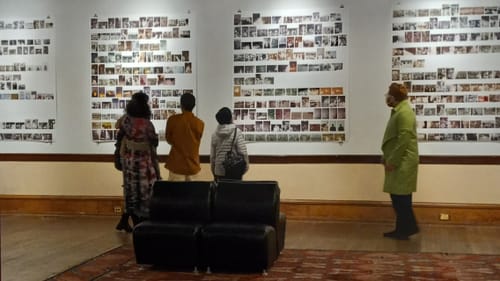Stay in the Loop
BSR publishes on a weekly schedule, with an email newsletter every Wednesday and Thursday morning. There’s no paywall, and subscribing is always free.
The truth about family photos
William Way LGBT Community Center presents Selections from the Archives: Rami George

Every January, we imagine what the future holds in the new year, but it’s also an important time to reflect on the past. Although we could do this with yearly recaps generated by social-media algorithms, we also need materials more carefully curated from farther back into our history. Selections from the Archives at the William Way LGBT Community Center gives Philadelphia’s queer community the chance to explore and connect with our history through archival materials selected by Philadelphia-based interdisciplinary artist Rami George.
Precious missing images
When you enter the right side of the exhibition, there are miscellaneous photographs, protest posters, and ephemera. A video piece at the far end of the wall shows a hand flipping through even more photographs. Although there was a printed gallery guide, I immediately found myself looking for labels to add more context (despite the fact that labels often distract me from genuine interactions with the work). Without any to read, I instead found myself drawn to a photo collage. It’s a white board with snapshots of the LGBT Community Center in the early 1990s taped to it with hand-written descriptions like “Team Philadelphia - Gay Games IV - 1994,” “Pride Parade - 1991,” or “Board of Directors 1993-94.” Half of the photographs are missing, leaving behind traces of tape.
While many curators might not show this photo collage in its current state, I found the inclusion of this piece to be a beautiful gesture. It reminds me of words by Ann Cvetkovich: that artists are “important curators of queer archives because they have a knack not only for valuing objects that others do not, but also for exhibiting them in ways that can capture both their felt value and their historical value (and make claims for felt value as historical value).”
Presented as a piece of art, the collage’s missing photographs become just as important as the remaining ones by foregrounding their importance as material objects (especially in a time when so many images we consume are digital). And although the piece is now protected with glass and under the watchful care of the archives, the missing images make the remaining ones seem even more precious, poetically making visible time’s effect on objects, the fading of memories, and our own mortality.
Take your time
On the left side of the gallery, large sheets of paper tower over the viewer, containing hundreds of scanned 5x7 photographs. The photographs in this section were taken for Au Courant, a Philadelphia-based LGBT news publication that operated from 1982-2000. Rather than being organized by theme or chronologically, these are sorted by their box within the archives. The range of the photographs is impressive, pivoting from monumental to personal: protests in DC, a couple embracing in bed, a leather contestant on a stage, a dog, a pride march, someone smiling in an office.

With the sheer number of photographs, I occasionally found my attention drifting. For a moment, it felt like sifting through someone’s shoebox of old photographs, until I found something to catch my attention and draw me in again. In this way, the exhibition rewards a leisurely viewer who takes their time to absorb the photographs, individually and as a whole.
Part of the exhibition
As I waited for friends to arrive, I found myself people-watching. Unlike most exhibition openings, whose guests have their backs to the artwork to talk to each other, people had conversations facing the walls, pointing to the photographs. I saw an adult guide a child through the gallery space, explaining the photographs of the AIDS quilt. I saw Rami George, engaged in conversations about the many photographs they selected. And I stood next to two older men, who found themselves within the hundreds of photographs.
I began thinking that if the viewers are within the photographs, then the people viewing the photographs are also a part of the exhibition, like participants in a performance. Instead of having tedious wall text with detailed historical information, Selections from the Archives generates discussions and conversations. Would you have wall text in your home next to family photos? Neither do we.
What, When, Where
Selections from the Archives: Rami George. Curated by Rami George. Through February 23, 2023, at William Way LGBT Community Center,1315 Spruce Street, Philadelphia. (215) 732-2220 or waygay.org.
Accessibility
William Way is a wheelchair-accessible venue.
Sign up for our newsletter
All of the week's new articles, all in one place. Sign up for the free weekly BSR newsletters, and don't miss a conversation.
 Jake Foster
Jake Foster